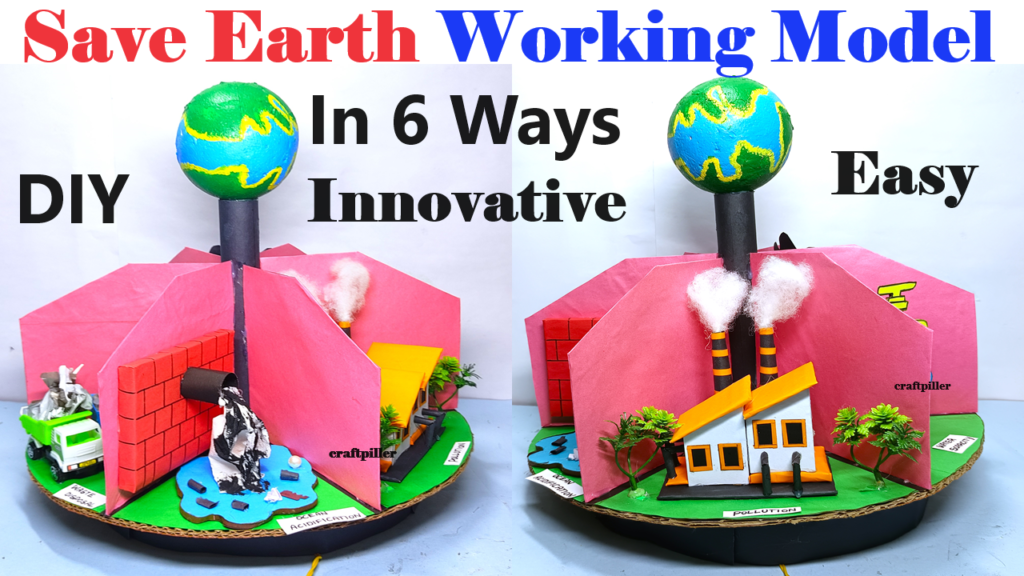To raise awareness about environmental issues and the importance of conservation efforts in preserving the Earth’s ecosystems, biodiversity, and natural resources.
The model serves as a visual reminder of the fragility of the planet and the urgent need for action to address environmental challenges.
Creating a “Save Earth” working model incorporating concepts like ocean acidification, pollution reduction, water conservation, waste disposal, global warming, and acid rain is a wonderful way to raise awareness about environmental issues.

Here’s a DIY model you can make:
Materials Needed:
- Large cardboard box or foam board
- Blue construction paper or paint
- Green construction paper or paint
- White cotton balls or cotton batting
- Small plastic animals or fish (optional)
- Toy cars or vehicles (optional)
- Plastic bottles, cans, and other recyclable waste materials
- Glue
- Scissors
- Markers
- Small LED light or flashlight
Steps by Steps Video Instructions:
1. Create the Earth:
- Use the large cardboard box or foam board as the base.
- Cover the base with blue construction paper or paint to represent the oceans.
- Cut out continents from green construction paper or paint and glue them onto the blue base to represent landmasses.
2. Depict Ocean Acidification:
- Cut out strips of blue construction paper and attach them to the sides of the box to form waves.
- Cut out small fish shapes from construction paper or use plastic fish toys and glue them onto the blue base.
- Use markers to draw sad or distressed faces on some of the fish to represent the impact of ocean acidification.
3. Show Pollution Reduction:
- Place plastic bottles, cans, and other recyclable waste materials on the land areas.
- Draw or glue pictures of recycling symbols on some of the waste items.
- Use markers to draw a factory or industrial area emitting smoke or pollutants and draw a “no smoking” sign next to it.
4. Demonstrate Water Conservation:
- Draw or paint a faucet or tap on one corner of the Earth.
- Use cotton balls or cotton batting to represent clouds above the faucet.
- Draw a water drop symbol next to the faucet with an arrow pointing to it.
- Write “Save Water” or “Conserve Water” near the faucet.
5. Illustrate Waste Disposal:
- Place some of the plastic waste items in designated trash bins or recycling bins on the land areas.
- Use markers to draw a landfill or garbage dump area and write “Reduce Waste” or “Proper Disposal” nearby.
6. Portray Global Warming:
- Cut out small sun shapes from yellow construction paper or use a small LED light or flashlight to represent the sun.
- Position the sun above the Earth and draw or paint rays extending towards it.
- Draw or glue images of melting ice caps or polar bears on icebergs to represent the effects of global warming.
7. Show Acid Rain:
- Draw or paint dark clouds above the Earth.
- Use markers to draw raindrops falling from the clouds.
- Write “Acid Rain” near the clouds.
8. Display:
- Once everything is in place, display your “Save Earth” model at school, in your community, or at a science fair.
- Create an information board or signs explaining each part of the model and the environmental issues it represents.
By following these steps, you can create an engaging and informative “Save Earth” working model that highlights important environmental issues and encourages others to take action.

